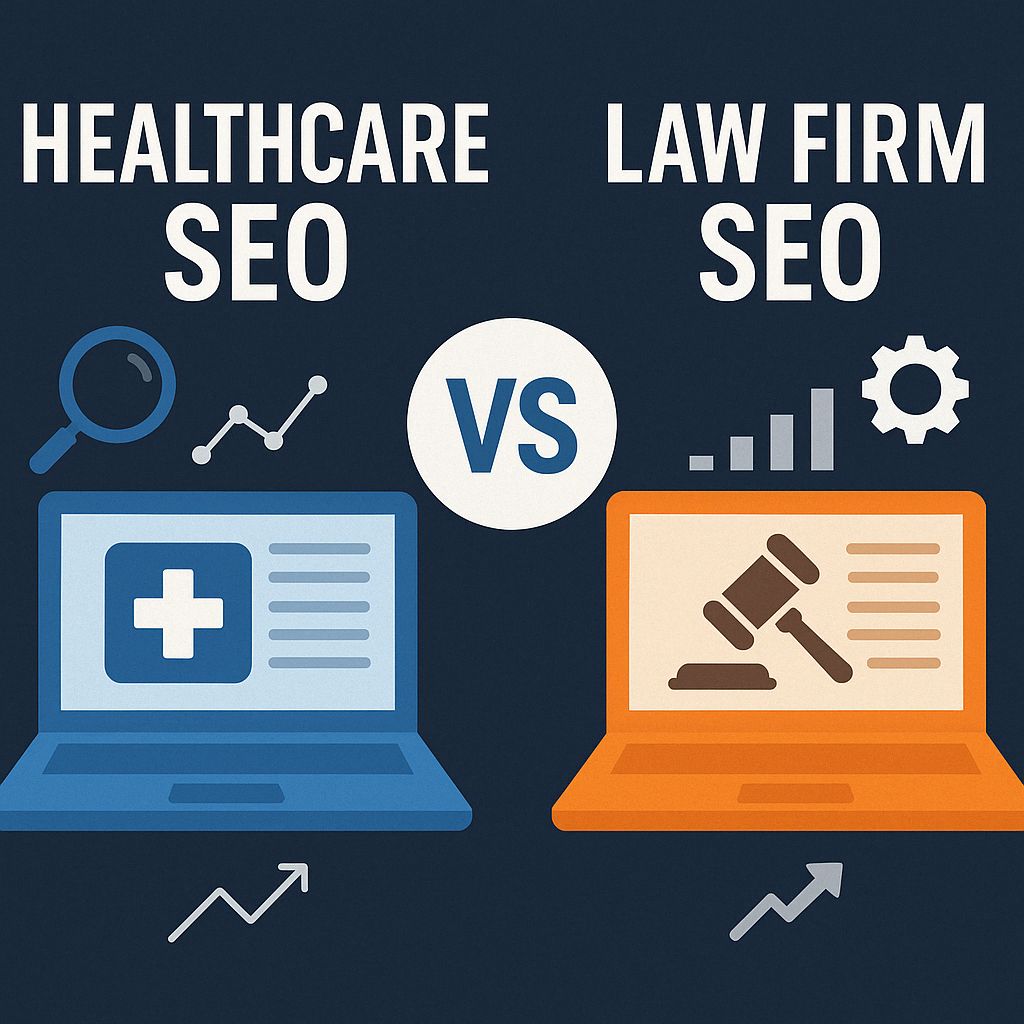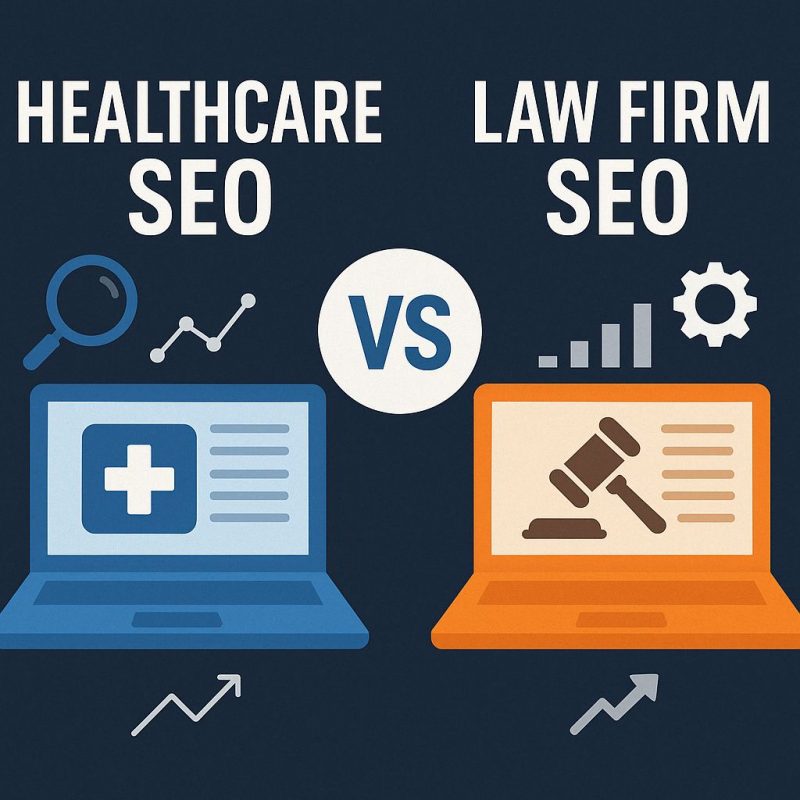Two high-trust industries. One search engine. Completely different strategies.
When Visibility Means Survival
No two industries carry more weight online than healthcare and law, because in both, the wrong information doesn’t just cost clicks. It can change lives. Whether someone’s facing a medical decision or a legal one, search engines have become their first advisor, and the margin for error is razor-thin.
At first glance, SEO strategies for doctors and attorneys might look alike. But underneath that shared surface—reviews, local visibility, credibility—live entirely different behaviors, regulations, and audience expectations. This guide compares what these industries share, what divides them, and how to build an SEO strategy that actually fits the stakes involved.
Shared SEO Foundations
Though tactics may diverge, both industries rely on several non-negotiable foundations. These areas are where healthcare and law firms often follow the same rules, because Google’s expectations don’t change, even if your audience does.
1. Local SEO is Non-Negotiable
Both healthcare providers and law firms depend heavily on local search visibility. It’s not enough to rank. Your business must show up where the service is needed most. That makes Local SEO not a bonus, but a baseline.
- Google Business Profile Optimization
A well-maintained GBP builds trust and proximity in map results. Businesses should include accurate categories, high-resolution photos, Q&A responses, and updated holiday hours. Reviews here often serve as your first impression before your website is even clicked. - Location-Based Keywords
Searches like “dermatologist near me” or “DUI lawyer Macon” reveal strong commercial intent. These phrases should appear naturally in page titles, meta descriptions, and content headers. Strategic placement increases the chances of appearing in local packs and SGE summaries. - Citations and Directories
Sites like Healthgrades, ZocDoc, Avvo, and FindLaw remain powerful for vertical SEO. Listing consistency in name, address, and phone number helps validate your business. A strong local link profile boosts both trust and map visibility.
2. E-E-A-T Is a Survival Standard
E-E-A-T—Experience, Expertise, Authoritativeness, and Trustworthiness—is a ranking reality in regulated industries. Google demands stronger credibility signals when people’s health or legal standing is at risk. And that burden of proof is public-facing.
- Professional Credentials and Author Bios
Doctor and attorney bios need more than job titles. Full educational histories, certifications, and bar affiliations help build trust with users and search engines alike. Including these on every page adds depth to your domain. - Reviews and Testimonials
In both fields, potential clients want evidence. Verified testimonials, with disclaimers where necessary, provide proof of impact. The key is transparency. False promises harm more than no claims at all. - Affiliations and Recognitions
Third-party associations (e.g., hospital networks, legal associations) signal legitimacy. Awards like “Top Dentist 2023” or “Super Lawyer” improve perceived authority. Schema markup can help surface these signals visually in search results.
3. Technical SEO Standards Apply Across the Board
Whether it’s a clinic site or a defense firm landing page, technical integrity is non-negotiable. Performance, stability, and accessibility affect rankings, user trust, and conversion.
- Mobile Optimization and Core Web Vitals
More than 60% of traffic in both sectors arrives via mobile. Sites must load in under 2.5 seconds, avoid layout shifts, and deliver seamless tap-to-call or booking functions. Tools like PageSpeed Insights and Lighthouse should be part of monthly audits. - Secure Data Handling
SSL certificates are just the beginning. Form encryption, HIPAA-compliant data handling (for healthcare), and cookie consent compliance are musts. Users expect professional-grade digital security. - Crawlability and Structured Data
Schema.org markup—LegalService, Physician, Organization, LocalBusiness—helps Google understand page intent. Clean site architecture ensures efficient crawling and internal link equity. Technical SEO here isn’t support. It’s infrastructure.
Where SEO Strategy Must Diverge
Despite these shared pillars, SEO tactics that win in one vertical can absolutely fail in the other. Here’s where it gets specific and strategic.
4. Search Intent and User Psychology
Healthcare users often begin with curiosity or mild concern. Legal users often begin in panic. That single contrast alters how SEO should approach query intent.
- Healthcare: Educational Entry
Searches like “what causes lower back pain” are common precursors to “chiropractor near me.” Informational content must guide without overwhelming. Early trust converts into long-term engagement. - Legal: Decision-Focused Entry
Queries like “DUI lawyer Macon” often follow a triggering event. Users want assurance, action steps, and a phone number. Content must reduce fear, not increase confusion. - Implication:
Healthcare SEO needs layered content journeys. Law firm SEO needs rapid reassurance and fast routes to action.
5. Regulatory Constraints and Compliance Pressure
Mistakes in either industry don’t just impact rankings. They invite fines or lawsuits. SEO execution must be filtered through compliance strategy.
- HIPAA for Healthcare
Patient data, even in anonymized form, must be protected. Testimonials need release forms. Contact forms must use secure transmission. - ABA and State Bar Rules for Legal
Avoid using “guaranteed results” or “we win every case.” Claims must be factual and provable. Misleading language can trigger ethical investigations. - Implication:
SEO copywriters in both sectors must be compliance-aware, or risk exposure for their clients.
6. Content Style and Formatting Expectations
In healthcare, complexity adds trust. In law, clarity removes fear. That means the same paragraph structure won’t work in both industries.
- Healthcare Content:
Should include clinical explanations, research citations, and long-form educational guides. Visuals like infographics and procedural videos perform well. - Legal Content:
Should focus on outcomes, timelines, and simplified processes. The tone must be calm, authoritative, and reassuring. - Best Practice:
Write for the reader’s mental state. Empathy is the most underused ranking factor in SEO.
7. Conversion Paths Look Nothing Alike
The click-to-call journey in legal SEO is short and direct. In healthcare, it’s slow and system-driven. Conversion logic must respect timing and trust.
- Healthcare Conversions:
Usually go through insurance verification, provider lookup, and availability screening. A “Book Now” button needs backend support and confirmation flow. - Legal Conversions:
Often end in a call, form fill, or live chat within minutes. Free consultations should be accessible from every major page. - Takeaway:
Healthcare requires a system. Law requires immediacy. Build accordingly.
8. Backlink Strategy and Authority Signals
Both sectors benefit from backlinks, but the source and narrative around them differ.
- Healthcare SEO:
Prioritize academic journals, health databases, hospital partners, and .edu mentions. Authority is built through institutional affiliation. - Law Firm SEO:
Focus on Avvo, Justia, bar directories, and guest posts on niche legal blogs. Authority is built through legal niche credibility. - Avoidance:
Don’t buy links. Don’t trade. And don’t use vendors who say “we do SEO for both,” because they likely don’t understand either.
9. Social Media and Visibility Behavior
While not a direct ranking factor, social visibility supports branded search and backlink growth. But the channels and tone differ dramatically.
- Healthcare:
Visual storytelling thrives—short clips, myth-busting TikToks, Instagram explainers. Focus on community building and non-urgent trust signals. - Law Firms:
Use YouTube for case explainers, LinkedIn for thought leadership, and Facebook for direct community response. Focus on real outcomes and legal education. - Pro Tip:
Don’t chase virality. Chase relevance to user pain points.
10. Platform Tools and Operational SEO Support
Infrastructure shapes performance—especially when high-value data is being passed through your site.
- Healthcare:
Needs HIPAA-compliant forms, portal integrations, appointment scheduling, and multi-provider directories. CRMs must handle sensitive information and data retention protocols. - Law Firms:
Need intake tools, e-signature options, call tracking, and rapid contact mechanisms. Efficiency trumps complexity. - Takeaway:
SEO isn’t just about visibility. It’s about what happens once the user finds you.

Conclusion: You Can’t Copy-Paste Strategy Across Regulated Industries
Healthcare and law may both be trust-driven, but the way that trust is built, signaled, and converted is entirely different. If your SEO strategy doesn’t reflect those differences, it’s not a strategy. It’s guesswork in a suit.
Learn how your users think. Learn how they panic, process, decide. Then build SEO around that, not around a template.
This is how competitive professionals win in search:
Not by optimizing everything. By optimizing what matters most to their industry.

